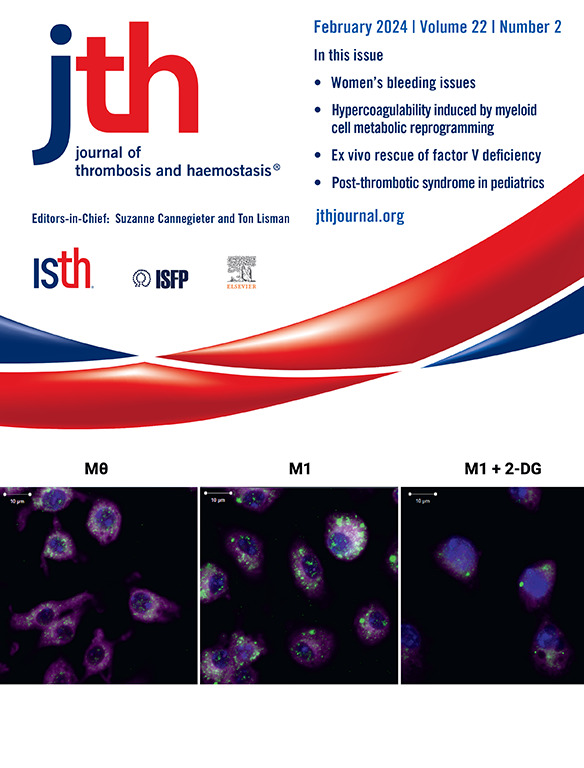中度血友病a患者的因子VIII k163n突变(FVIII-Nara)对凝血酶催化的涉及P4'位置的Arg1689切割产生抗性。
IF 5
2区 医学
Q1 HEMATOLOGY
引用次数: 0
摘要
背景:一些非严重血友病(H)A患者被诊断为FVIII因子活性(FVIII:C)相对于FVIII抗原(FVIII:Ag)降低,并被归类为交叉反应性物质阳性(CRM+)。我们之前发现了一种新的FVIII- lys1693asn (K1693N)自然突变,具有中等表型的HA (FVIII:C/FVIII:Ag=1.9 IU/dL/124 IU/dL)。目的:探讨CRM+表型中凝血酶切割位点上P4'位点的作用机制。方法/结果:利用BHK细胞制备的重组FVIII- k1693n在凝血酶激活后,在Arg1689位点裂解严重延迟,FVIII:C峰水平非常低。然而,凝血酶激活后的FVIII- k1693a突变显示了FVIII:C峰轻度降低和与野生型相似的裂解。这些发现表明向Asn at P4'位点的转化介导了凝血酶耐药。HA遗传数据库中的FVIII-K376N基因与FVIII-K1693N基因相似,在凝血酶切割位点P4′发生lysto - asn突变,可能存在共同机制。FVIII- k376n和FVIII- k376a的FVIII特异性活性分别为野生型的6.1%和3.1%(一期测定)。两种突变体的凝血酶催化的Arg372裂解与野生型相当,但凝血酶催化的FVIII激活严重抑制。FVIII-K376N (k=0.53)和FVIII-K376A (k=0.99)与野生型(k=0.32)相比,FVIII-K376N (k=0.53)和FVIII-K376A (k=0.99)活性的自发衰减率更高,这表明Arg372切割后P4'位点的切割有助于A1-A2结构域的相互作用。结论:位于P4位点的Lys1693和Lys376通过不同的机制影响FVIII的功能,表明患者来源的突变可以揭示FVIII激活的功能方面。本文章由计算机程序翻译,如有差异,请以英文原文为准。
The factor (F)VIII K1693N mutation (FVIII-Nara) in a patient with moderate hemophilia A confers resistance to thrombin-catalyzed cleavage at Arg1689 involving P4ʹ position
Background
Some patients with nonsevere hemophilia A (HA) are diagnosed with reduced factor (F)VIII activity (FVIII:C) relative to FVIII antigen (FVIII:Ag) and are classified as cross-reactive material-positive. We previously found a novel FVIII-Lys1693Asn (K1693N) natural mutation in a patient with HA with moderate phenotype (FVIII:C/FVIII:Ag = 1.9 IU/dL/124 IU/dL).
Objective
To examine the mechanism(s) involving the P4ʹ site on thrombin cleavage site at Arg1689 in a cross-reactive material-positive phenotype.
Methods
FVIII-K1693N and its comparison variant K1693A were analyzed for t thrombin-mediated activation. FVIII-K376N, listed in the HA database due to a similar Lys-to-Asn substitution, was examined with K376A as its comparison. All mutants were expressed in BHK cells.
Results
FVIII-K1693N showed delayed cleavage at Arg1689 and low peak FVIII:C, while FVIII-K1693A showed mildly reduced FVIII:C after thrombin activation. Mildly reduced peak FVIII:C and similar cleavage to wild-type was illustrated, however, with the FVIII-K1693A mutation after thrombin activation. These findings indicated that the conversion to Asn at P4ʹ site mediated thrombin resistance. FVIII specific activities of FVIII-K376N and FVIII-K376A were 6.1%/3.1% (one-stage assay) of wild-type, respectively. Thrombin-catalyzed cleavage at Arg372 was comparable to wild-type with both mutants, but thrombin-catalyzed FVIII activation was severely-depressed. Spontaneous decay rates of FVIIIa activity with FVIII-K376N (k = 0.53) and FVIII-K376A (k = 0.99) were greater compared to wild-type (k = 0.32), suggesting that cleavage of P4ʹ site following cleavage at Arg372contributed to A1-A2 domainal interaction.
Conclusion
Lys1693 and Lys376, both located at P4ʹ sites, are suggested to influence FVIII function via distinct mechanisms, indicating that patient-derived mutations can reveal functional aspects of FVIII activation.
求助全文
通过发布文献求助,成功后即可免费获取论文全文。
去求助
来源期刊
CiteScore
24.30
自引率
3.80%
发文量
321
审稿时长
1 months
期刊介绍:
The Journal of Thrombosis and Haemostasis (JTH) serves as the official journal of the International Society on Thrombosis and Haemostasis. It is dedicated to advancing science related to thrombosis, bleeding disorders, and vascular biology through the dissemination and exchange of information and ideas within the global research community.
Types of Publications:
The journal publishes a variety of content, including:
Original research reports
State-of-the-art reviews
Brief reports
Case reports
Invited commentaries on publications in the Journal
Forum articles
Correspondence
Announcements
Scope of Contributions:
Editors invite contributions from both fundamental and clinical domains. These include:
Basic manuscripts on blood coagulation and fibrinolysis
Studies on proteins and reactions related to thrombosis and haemostasis
Research on blood platelets and their interactions with other biological systems, such as the vessel wall, blood cells, and invading organisms
Clinical manuscripts covering various topics including venous thrombosis, arterial disease, hemophilia, bleeding disorders, and platelet diseases
Clinical manuscripts may encompass etiology, diagnostics, prognosis, prevention, and treatment strategies.

 求助内容:
求助内容: 应助结果提醒方式:
应助结果提醒方式:


